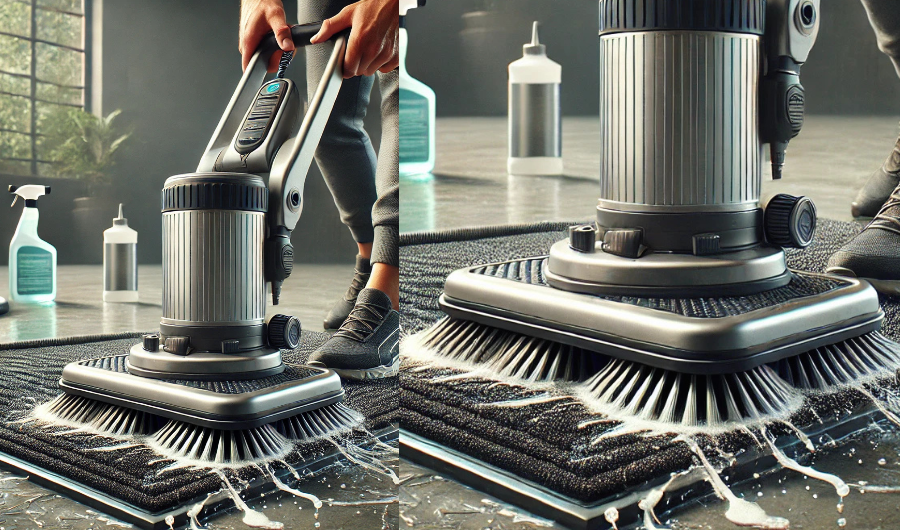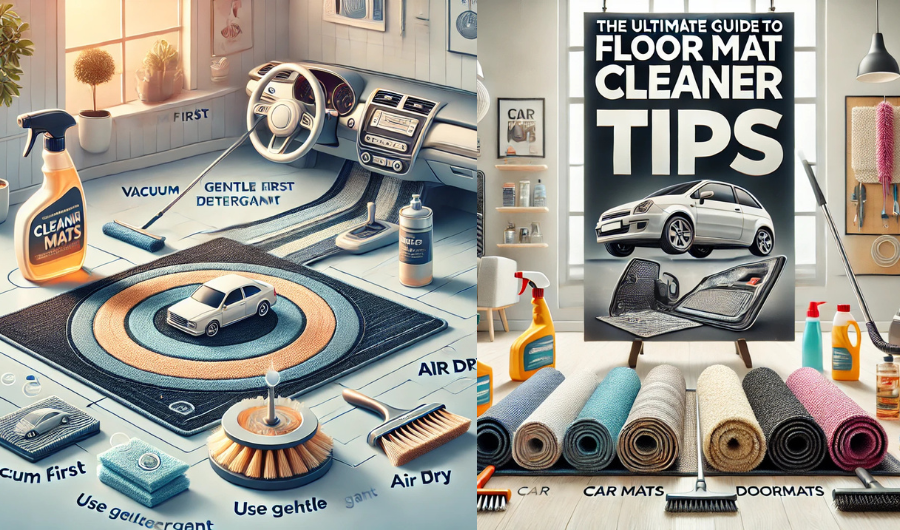Floor mats are the first line of defense against dirt, moisture, and debris in homes, cars, and commercial spaces. Over time, these mats accumulate grime, stains, and odors, detracting from their appearance and jeopardising hygiene. Using a floor mat cleaner is essential for keeping your mats clean, fresh-smelling, and long-lasting. This guide delves into the best cleaning practices, cleaner types, and maintenance tips for various types of floor mats to help you keep them in good condition.
Why Floor Mat Cleaning Is Important
Maintaining clean floor mats is about more than appearance; it’s also about hygiene and durability. Here’s why keeping your mats clean should be a priority:
- Prevents Buildup of Dirt and Germs: Mats trap dirt, allergens, and bacteria. Regular cleaning reduces allergens and keeps your environment healthy.
- Extends Mat Lifespan: Dirt particles act as abrasives, causing mats to wear down faster. Proper cleaning helps mats last longer.
- Reduces Odors: Accumulated grime can lead to unpleasant odors. Cleaning keeps your mats fresh-smelling.
- Improves Appearance: Clean mats enhance the look of any space, making it feel tidy and well-maintained.
Types of Floor Mat Cleaners

Not all floor mat cleaners are alike. Choose a cleaner that is appropriate for your mat’s material and level of cleaning. Here are a few common types:
- Foam Cleaners: Ideal for spot cleaning, foam cleaners are sprayed onto the mat and wiped away. They are suitable for light stains and are generally safe to use on fabrics and rubber mats.
- Shampoo Cleaners: Designed for deep cleaning, shampoo cleaners are combined with water and scrubbed into the mat. They work well on both fabric and rubber mats, removing stains and odors.
- Spray Cleaners: These are convenient, ready-to-use solutions that can be sprayed directly onto mats. They are perfect for quick cleaning of surface dirt and are generally suitable for all types of mats.
- Steam Cleaners: For heavily soiled mats, steam cleaners provide a chemical-free solution. The heat and pressure lift deep-seated dirt and sanitize the mat.
- Carpet Extractors: Often used by professionals, carpet extractors are ideal for fabric mats because they apply cleaning solution and then vacuum it up. This method is suitable for thorough cleaning.
Step-by-Step Guide to Cleaning Floor Mats
To effectively clean car mats, entrance mats, or kitchen floor mats, follow these steps.
1. Prepare Your Cleaning Area
- Choose a well-ventilated location where water spills will not cause problems.
- Gather your cleaning supplies, such as the mat cleaner, a brush, water, and a microfiber cloth.
2. Shake and Vacuum the Mats
- Remove the mats from their current location and shake off any loose dirt and debris.
- Use a vacuum cleaner to get rid of fine dust and particles. For car mats, a handheld vacuum is ideal.
3. Apply the Floor Mat Cleaner
- Choose a cleaner that is appropriate for your mat type. A shampoo or foam cleaner is best for fabric mats, whereas a spray cleaner works well for rubber mats.
- Apply the cleaner evenly across the mat, with a focus on stained or high-traffic areas.
4. Scrub the Mat
- To work the cleaner into the mat, use a soft or medium bristle brush. Rub in circular motions to remove dirt and stains.
- For rubber mats, a sponge may be more effective for spreading cleaner and removing dirt.
5. Rinse Thoroughly
- Rinse the mat thoroughly in clean water. To remove cleaning residue from fabric mats, use a hose or a bucket of water.
- Rubber mats should be cleaned with a damp cloth or rinsed with a hose.
6. Dry the Mat Properly
- Allow the mat to completely dry before returning it. Consider hanging car mats in a sunny spot.
- Avoid direct heat sources, as they can damage the mat material, particularly rubber mats.
Cleaning Tips for Different Types of Floor Mats
Different mat materials necessitate distinct cleaning methods in order to avoid damage and ensure a thorough cleaning. Here’s how to manage each type:
Fabric Mats
Fabric mats are commonly used in homes and automobiles. How to clean fabric mats effectively:
- Use a shampoo cleaner or foam spray.
- Scrub gently with a soft brush to avoid damaging the fibers.
- Rinse with lukewarm water, as hot water can shrink the fabric.
- Air dry completely to prevent mold or mildew.
Rubber Mats
Rubber mats are popular in high-traffic areas due to their durability and resistance to water. When cleaning the rubber mats:
- Choose a non-corrosive spray cleaner or a mild soap and water mixture.
- Scrub with a sponge or soft brush, as hard bristles may scratch the rubber.
- Avoid using harsh chemicals, as they can cause the rubber to degrade.
- Rinse thoroughly and air dry, but avoid prolonged sun exposure.
Carpeted Mats
Carpeted mats are common in commercial settings and some automobiles. For those:
- Use a carpet extractor for deep cleaning or a shampoo cleaner for manual cleaning.
- Spot treat stains before a full wash.
- Vacuum first to remove loose debris, and air dry completely before reuse.
Tips for Choosing the Right Floor Mat Cleaner
Choosing the right cleaner is critical for effective cleaning without causing damage. Here’s what you should consider:
- Mat Material Compatibility: Determine whether the cleaner is suitable for fabric, rubber, or carpet mats.
- Stain Type: Some cleaners are designed specifically for grease, dirt, or salt stains; choose accordingly.
- Fragrance: Some cleaners include fragrance, which can be beneficial for mats used indoors or in cars.
- Eco-Friendliness: Choose biodegradable cleaners to reduce environmental impact, especially if you’re cleaning mats outside.
Maintenance Tips to Keep Your Mats Cleaner for Longer
Regular maintenance reduces the need for deep cleaning and increases the lifespan of your mats. Here’s how to keep them in great shape:
- Vacuum Weekly: A quick vacuum prevents dirt from becoming embedded in the mat fibres.
- Rotate Mats: If you have more than one mat, rotate them regularly to ensure even wear.
- Spot Clean Stains Immediately: Spills or stains should be cleaned up as soon as possible to avoid setting.
- Apply Protective Spray to Fabric Mats: Some sprays repel dirt and liquids, making it easier to clean mats over time.
DIY Floor Mat Cleaner Recipes
If you prefer a natural alternative, consider making a DIY mat cleaner with ingredients you probably already have at home:
- Vinegar and Baking Soda Solution: Combine equal parts white vinegar and water, then sprinkle baking soda over the stains before applying the solution. This is effective on fabric mats for odour removal and light stains.
- Lemon Juice and Water: For rubber mats, combine lemon juice and water and apply with a sponge. Lemon is a natural cleaner that leaves a refreshing scent.
- Dish Soap and Warm Water: For general cleaning, combine a few drops of dish soap with warm water. It is suitable for both fabric and rubber mats and effectively removes dirt.
Final Words
Keeping your floor mats clean is critical for creating a fresh and sanitary environment. With the right floor mat cleaner, regular maintenance, and proper cleaning techniques, you can extend the life of your mats and keep them looking like new. Whether you use a commercial cleaner or a DIY solution, following these steps will keep your mats in great condition for years to come.

